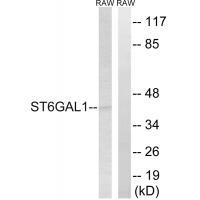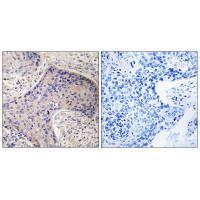

| WB | 咨询技术 | Human,Mouse,Rat |
| IF | 咨询技术 | Human,Mouse,Rat |
| IHC | 1/50-1/100 | Human,Mouse,Rat |
| ICC | 技术咨询 | Human,Mouse,Rat |
| FCM | 咨询技术 | Human,Mouse,Rat |
| Elisa | 咨询技术 | Human,Mouse,Rat |
| Aliases | Alpha 2; 6-ST; B-cell antigen CD75; Beta-galactoside alpha-2; 6-sialyltransferase |
| Entrez GeneID | 6480; |
| WB Predicted band size | 42kDa |
| Host/Isotype | Rabbit IgG |
| Antibody Type | Primary antibody |
| Storage | Store at 4°C short term. Aliquot and store at -20°C long term. Avoid freeze/thaw cycles. |
| Species Reactivity | Human,Mouse |
| Immunogen | Synthesized peptide derived from internal of human ST6GAL1. |
| Formulation | Purified antibody in PBS with 0.05% sodium azide. |
+ +
以下是关于ST6GAL1抗体的3篇参考文献及其摘要概括:
1. **"ST6GAL1 expression is upregulated in colon cancer tumors and modulates carcinoma cell proliferation"**
*作者:Hassanpour, S. et al. (2016)*
摘要:该研究通过免疫组化和Western blot分析,发现结肠癌组织中ST6GAL1蛋白表达显著升高,其抗体检测证实该酶通过调控β-catenin信号通路促进肿瘤细胞增殖和转移。
2. **"ST6GAL1-mediated sialylation regulates ovarian cancer cell chemoresistance"**
*作者:Britain, C. M. et al. (2018)*
摘要:研究利用ST6GAL1特异性抗体进行流式细胞术分析,发现卵巢癌细胞表面唾液酸化水平升高与化疗耐药性相关,抑制ST6GAL1可增强顺铂的细胞毒性作用。
3. **"ST6GAL1 promotes immunosuppression in pancreatic cancer by enhancing sialylation of immune checkpoint proteins"**
*作者:Liu, Y. et al. (2020)*
摘要:通过免疫沉淀和抗体阻断实验,研究发现ST6GAL1介导的PD-1/CTLA-4唾液酸化抑制T细胞活性,靶向ST6GAL1可逆转肿瘤微环境中的免疫抑制状态。
4. **"ST6GAL1 regulates B cell activation via α2.6-sialylation of CD45"**
*作者:Lee, J. et al. (2019)*
摘要:研究使用ST6GAL1敲除小鼠及抗体检测技术,证明该酶通过修饰CD45的唾液酸化水平调控B细胞受体信号通路,影响抗体产生和自身免疫反应。
The ST6GAL1 antibody is a tool used to detect ST6 beta-galactoside alpha-2.6-sialyltransferase 1 (ST6GAL1), a key enzyme in protein glycosylation. ST6GAL1 catalyzes the transfer of sialic acid to terminal galactose residues on glycoproteins and glycolipids, forming α2-6-linked sialylation—a modification critical for cell-cell interactions, immune modulation, and protein stability. This enzyme is widely expressed in tissues like the liver, placenta, and immune cells, and its dysregulation is implicated in cancer progression, inflammatory diseases, and neurodegenerative disorders.
Antibodies targeting ST6GAL1 enable researchers to study its expression patterns, subcellular localization, and role in pathological processes. For instance, elevated ST6GAL1 levels in cancers (e.g., colon, pancreatic, ovarian) correlate with enhanced metastasis, drug resistance, and immune evasion via sialylation-mediated masking of tumor antigens. In Alzheimer’s disease, altered ST6GAL1 activity may affect amyloid precursor protein processing.
These antibodies are essential in techniques such as Western blotting, immunohistochemistry, and flow cytometry. Clone-specific variations (e.g., 3C1. 4B1) may differ in sensitivity and applications. Research using ST6GAL1 antibodies contributes to understanding glycan-mediated biological mechanisms and exploring therapeutic strategies, such as inhibiting sialylation to augment chemotherapy or immunotherapy efficacy. Validation remains crucial, as off-target binding can occur due to structural similarities among sialyltransferases.
×